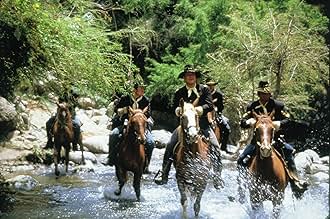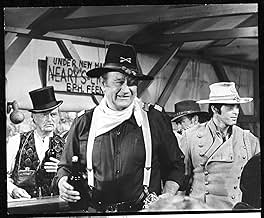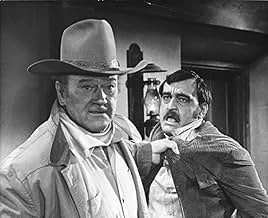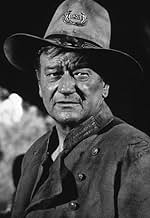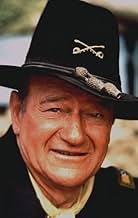Rio Lobo
- 1970
- Tous publics
- 1h 54m
IMDb RATING
6.7/10
15K
YOUR RATING
After the Civil War, Cord McNally searches for the two traitors whose treachery caused the defeat of McNally's unit and the loss of a close friend.After the Civil War, Cord McNally searches for the two traitors whose treachery caused the defeat of McNally's unit and the loss of a close friend.After the Civil War, Cord McNally searches for the two traitors whose treachery caused the defeat of McNally's unit and the loss of a close friend.
Featured reviews
After the Civil War, Cord McNally (John Wayne) searches for the traitor whose perfidy caused the defeat of McNally's unit, a shipment of gold to be stolen, and the loss of a close friend.
I loved the beginning with the train robbery. Every part of it was executed perfectly, and the first ten minutes or so are probably the highlight of the film. And then the idea that the yanks and rebels could be friends was questionable but nice... and the shift from the war and the heist to tracking down a traitor, great. But it seemed to have a good deal of turns and subplots that were not quite necessary.
The worst was Jennifer O'Neill, who played Shasta. I would gladly give this film another star if it was not for her. Every line was delivered so poorly. I guess Howard Hawks feared John Wayne was too old for the role... I thought Wayne was great. It was O'Neill that was the weak link. She just has no acting ability to speak of.
Also, a special nod to Jack Elam, who was the comic relief. His wit and delivery (almost) make up for O'Neill, and on that count I have revised my 6 stars in 2015 to 7 stars in 2016 upon a second viewing. This may not be the best known Hawks-Wayne collaboration, but it certainly has its strong points.
I loved the beginning with the train robbery. Every part of it was executed perfectly, and the first ten minutes or so are probably the highlight of the film. And then the idea that the yanks and rebels could be friends was questionable but nice... and the shift from the war and the heist to tracking down a traitor, great. But it seemed to have a good deal of turns and subplots that were not quite necessary.
The worst was Jennifer O'Neill, who played Shasta. I would gladly give this film another star if it was not for her. Every line was delivered so poorly. I guess Howard Hawks feared John Wayne was too old for the role... I thought Wayne was great. It was O'Neill that was the weak link. She just has no acting ability to speak of.
Also, a special nod to Jack Elam, who was the comic relief. His wit and delivery (almost) make up for O'Neill, and on that count I have revised my 6 stars in 2015 to 7 stars in 2016 upon a second viewing. This may not be the best known Hawks-Wayne collaboration, but it certainly has its strong points.
After an excellent start with the train ambush, the movie loses steam and never really picks up, an unhappy way for a great director like Hawks to bow out. But I did not get too bored and was happy enough to stick it out to the end, even though the writing is too flat and derivative with echos of half a dozen better movies. Rivero lacks the charisma that could have helped to save things but I do not think O'Neill is as bad as some reviewers claim – not expressive enough with her dialogue at this stage but I think you can see the spark that gave her a respectable career in movies. But, as usual, Wayne saves the day. Even in a disappointing movie like this, that enormous screen presence reminds you just what a great star he was.
This has to be unique in the history of Hollywood. Leading director and screen legend Howard Hawks loved this film so much that they made three variations of the same movie. By the time Rio Lobo was made, the theme was getting a bit thin, but it's still grand entertainment.
The first part of the film is set during the Civil War with John Wayne pursuing Confederates who are stealing army payrolls. He does catch up with them and the Civil War ends. He befriends his erstwhile enemies and asks for their help in locating the informer who was giving them information.
That all sets the scene for the third variant of Rio Bravo/El Dorado theme. Playing the old codger part is Jack Elam who by now had quit being a screen menace and was doing comedy and doing it well. The two younger sidekicks are the former Confederate enemies, Jorge Rivero and Chris Mitchum.
Rio Lobo had the presence of two stars of the Mexican cinema, Jorge Rivero and Susana Dosamantes. Dosamantes played Mitchum's girlfriend and Jennifer O'Neill played the Angie Dickinson part although Wayne was now deciding he was too old for the romance. She pairs off with Rivero.
In a small bit part is Sherry Lansing who left acting soon after Rio Lobo and really hit the big time, going into the production end of the movie business and becoming head of first 20th Century Fox and later CEO of Paramount.
The two principal villains are Victor French who played the neighbor on Little House On The Prarie and Mike Henry who was one of several screen Tarzans.
It's a good John Wayne western and that takes in a whole lot of territory pilgrim.
The first part of the film is set during the Civil War with John Wayne pursuing Confederates who are stealing army payrolls. He does catch up with them and the Civil War ends. He befriends his erstwhile enemies and asks for their help in locating the informer who was giving them information.
That all sets the scene for the third variant of Rio Bravo/El Dorado theme. Playing the old codger part is Jack Elam who by now had quit being a screen menace and was doing comedy and doing it well. The two younger sidekicks are the former Confederate enemies, Jorge Rivero and Chris Mitchum.
Rio Lobo had the presence of two stars of the Mexican cinema, Jorge Rivero and Susana Dosamantes. Dosamantes played Mitchum's girlfriend and Jennifer O'Neill played the Angie Dickinson part although Wayne was now deciding he was too old for the romance. She pairs off with Rivero.
In a small bit part is Sherry Lansing who left acting soon after Rio Lobo and really hit the big time, going into the production end of the movie business and becoming head of first 20th Century Fox and later CEO of Paramount.
The two principal villains are Victor French who played the neighbor on Little House On The Prarie and Mike Henry who was one of several screen Tarzans.
It's a good John Wayne western and that takes in a whole lot of territory pilgrim.
I think that most John Wayne buffs would agree that this is a remake of 2 previous picture-"Rio Bravo",and "El Dorado".We have the same characters,the same basic situations,and the same resolutions.What I found interesting is the way that the "Duke"was able to kid his image in this one.He's not just strong,tough,brave,resourceful,and quick;he's also able to show a middle-aged man whose libido might not be as urgent as it was previously.Let's face it,being a lover isn't just performance,but also being tender and"comfortable"(the word that they use in this picture.)Let's not be too hasty about the performances of O'Neill,Rivero,and Mitchum-they were young and needed experience,and they got it in this film.(And Rivero is every bit as tasty looking as O'Neill.Isn't he delectable?)Nice to see Victor French as a porcine,slimy villain,and Mike Henry manages to play against his Tarzan image as the sheriff.I found him tough enough,and certainly brutish,but I didn't see him as quite enough of a sadist to go around cutting up women.David Huddleston does a first-rate job as Dr.Jones.The real acting honors of the evening,however,do go to the redoubtable Mr.Elam.This is a scenery-chewing,rip-roaring,over-the-top performance of such eye-rolling looniness that it's a joy to behold.Watch this film for fun,and don't take it too seriously.
When I decided to write a review of Rio Lobo, I had every expectation of visiting the website and finding that the movie's weighted average was a 2.5. I was pleasantly surprised to see that it's a 7.5, and that's actually a half-point higher than my own score. To cut to the chase: I liked Rio Lobo.
It was fashionable in 1970 to trash Rio Lobo because (a) it was the supposedly feeble, last effort of a great director, Howard Hawks, who had supposedly lost interest in the picture; (b) it was too derivative of Rio Bravo and El Dorado; (c) the Duke was too old to play the part of a cavalry colonel (to say nothing of being too big; the average cavalryman in the Civil War was 5'7" and 135 lbs.); (d) the supporting cast was pathetic; (e) the production values were poor; and (f) the movie paled in comparison to Little Big Man, which was released at the same time. Much of the criticism was true. But, it was fun to watch, anyway.
Ford had his cavalry trilogy, and Hawks had his Rio trilogy, and the Duke was in all six of them. The Ford set is a cut above the Hawks set, but all six films are worth watching. Ford was working with Wayne (1947-50) at a time when Wayne's acting ability was still very much in question. And Ford succeeded on every level, especially in She Wore a Yellow Ribbon, where the character development of Capt. Nathan Brittles (Wayne) is nothing but sheer genius. Hawks, on the other hand, had (by 1959, in Rio Bravo) a very established star, and was thereby free to dwell more on story telling than he was on character development. Besides, with those amazing exteriors, the cinemagography alone was worth the cost of admission to all six pictures.
The Duke was too old to play a romantic lead in this picture (but so was Cary Grant in his last picture, Walk, Don't Run, when he, too, was about 63 years-old.) The fact that he was not a "threat" to O'Neill's character (in those pre-Viagra days) was nothing more than an extension of the persona the Duke captured the year before in True Grit, and would continue to build on in such films as The Cowboys and The Shootist. Let's face it: Wayne was becoming a likeable old coot.
Hawks was, according to reports, disappointed in Jennifer O'Neill, and by the last reel, her part has been cut in favor of Sherry Lansing's part. (Hawks did the same thing to John Ireland's part in Red River, 30 years earlier.) Actually, O'Neill didn't do THAT bad. My problem with her is that she couldn't decide whether she would play her part as the New York high-fashion model that she was, or as Kim Darby reprising her role in True Grit. At times, O'Neill's semi-imitation of Darby gets on one's nerves.
And, Hawks was rightfully disappointed in the desultory performances of the supporting cast, with the exception of Lansing and Jack Elam. The Confederate cavalry captain: He might as well have been created by computer graphics, for all the vitality he brings to the role. But, take a look at the stock players, including Hank Worden ("Old Mose" in The Searchers) and Jim Davis (Jock Ewing of Dallas fame). These are virtually cameos, if not walk-on parts, but they are effective.
I do not think Hawks gave up on this film, at least, not to the extent that people have claimed. Yakima Canutt ably handled the second unit, and the train hijacking he directed (with Hawks' help) was unusual and exciting; the cinematography, but for the occasional lighting or filtering error, was acceptable; and the editing was fairly crisp. The interior sets were shabby, that is true.
But what carries the picture is the wonderful dialogue, and Wayne. The dialogue is "pure Hawks": spare, unambiguous, natural, and realistic. Wayne's onscreen personal is so great, and his presence so magnificent, that all of the films shortcomings are rendered irrelevant.
Thank you, Mr. Hawks. Well done.
It was fashionable in 1970 to trash Rio Lobo because (a) it was the supposedly feeble, last effort of a great director, Howard Hawks, who had supposedly lost interest in the picture; (b) it was too derivative of Rio Bravo and El Dorado; (c) the Duke was too old to play the part of a cavalry colonel (to say nothing of being too big; the average cavalryman in the Civil War was 5'7" and 135 lbs.); (d) the supporting cast was pathetic; (e) the production values were poor; and (f) the movie paled in comparison to Little Big Man, which was released at the same time. Much of the criticism was true. But, it was fun to watch, anyway.
Ford had his cavalry trilogy, and Hawks had his Rio trilogy, and the Duke was in all six of them. The Ford set is a cut above the Hawks set, but all six films are worth watching. Ford was working with Wayne (1947-50) at a time when Wayne's acting ability was still very much in question. And Ford succeeded on every level, especially in She Wore a Yellow Ribbon, where the character development of Capt. Nathan Brittles (Wayne) is nothing but sheer genius. Hawks, on the other hand, had (by 1959, in Rio Bravo) a very established star, and was thereby free to dwell more on story telling than he was on character development. Besides, with those amazing exteriors, the cinemagography alone was worth the cost of admission to all six pictures.
The Duke was too old to play a romantic lead in this picture (but so was Cary Grant in his last picture, Walk, Don't Run, when he, too, was about 63 years-old.) The fact that he was not a "threat" to O'Neill's character (in those pre-Viagra days) was nothing more than an extension of the persona the Duke captured the year before in True Grit, and would continue to build on in such films as The Cowboys and The Shootist. Let's face it: Wayne was becoming a likeable old coot.
Hawks was, according to reports, disappointed in Jennifer O'Neill, and by the last reel, her part has been cut in favor of Sherry Lansing's part. (Hawks did the same thing to John Ireland's part in Red River, 30 years earlier.) Actually, O'Neill didn't do THAT bad. My problem with her is that she couldn't decide whether she would play her part as the New York high-fashion model that she was, or as Kim Darby reprising her role in True Grit. At times, O'Neill's semi-imitation of Darby gets on one's nerves.
And, Hawks was rightfully disappointed in the desultory performances of the supporting cast, with the exception of Lansing and Jack Elam. The Confederate cavalry captain: He might as well have been created by computer graphics, for all the vitality he brings to the role. But, take a look at the stock players, including Hank Worden ("Old Mose" in The Searchers) and Jim Davis (Jock Ewing of Dallas fame). These are virtually cameos, if not walk-on parts, but they are effective.
I do not think Hawks gave up on this film, at least, not to the extent that people have claimed. Yakima Canutt ably handled the second unit, and the train hijacking he directed (with Hawks' help) was unusual and exciting; the cinematography, but for the occasional lighting or filtering error, was acceptable; and the editing was fairly crisp. The interior sets were shabby, that is true.
But what carries the picture is the wonderful dialogue, and Wayne. The dialogue is "pure Hawks": spare, unambiguous, natural, and realistic. Wayne's onscreen personal is so great, and his presence so magnificent, that all of the films shortcomings are rendered irrelevant.
Thank you, Mr. Hawks. Well done.
Did you know
- TriviaRobert Mitchum visited his son Christopher Mitchum during filming. Director Howard Hawks asked the elder Mitchum to reprise his El Dorado (1966) role as a drunken sheriff, but Mitchum claimed he was now retired. John Wayne responded, "Mitch has been retiring ever since the first day I met him."
- GoofsWhen uncoupling the train from the locomotive the rebels pull up on a lever opening the knuckle coupler and releasing the car. At the time of the Civil War railroads used a link and pin coupling system. The knuckle coupler was invented by Eli Janney in 1873, eight years after the civil war ended. They are still in use today.
- Quotes
Cord McNally: Do you think you could sneak up on the fella at the gate?
Phillips: I could sneak up on a *coyote* if I've a mind to!
Cord McNally: Did you get that fella at the gate?
Phillips: He's at *another* gate now, lookin' fer *Saint Peter*!
- ConnectionsFeatured in Plimpton! Shoot-Out at Rio Lobo (1970)
- How long is Rio Lobo?Powered by Alexa
Details
- Release date
- Countries of origin
- Languages
- Also known as
- Ріо Лобо
- Filming locations
- Production companies
- See more company credits at IMDbPro
Box office
- Budget
- $4,000,000 (estimated)
Contribute to this page
Suggest an edit or add missing content



